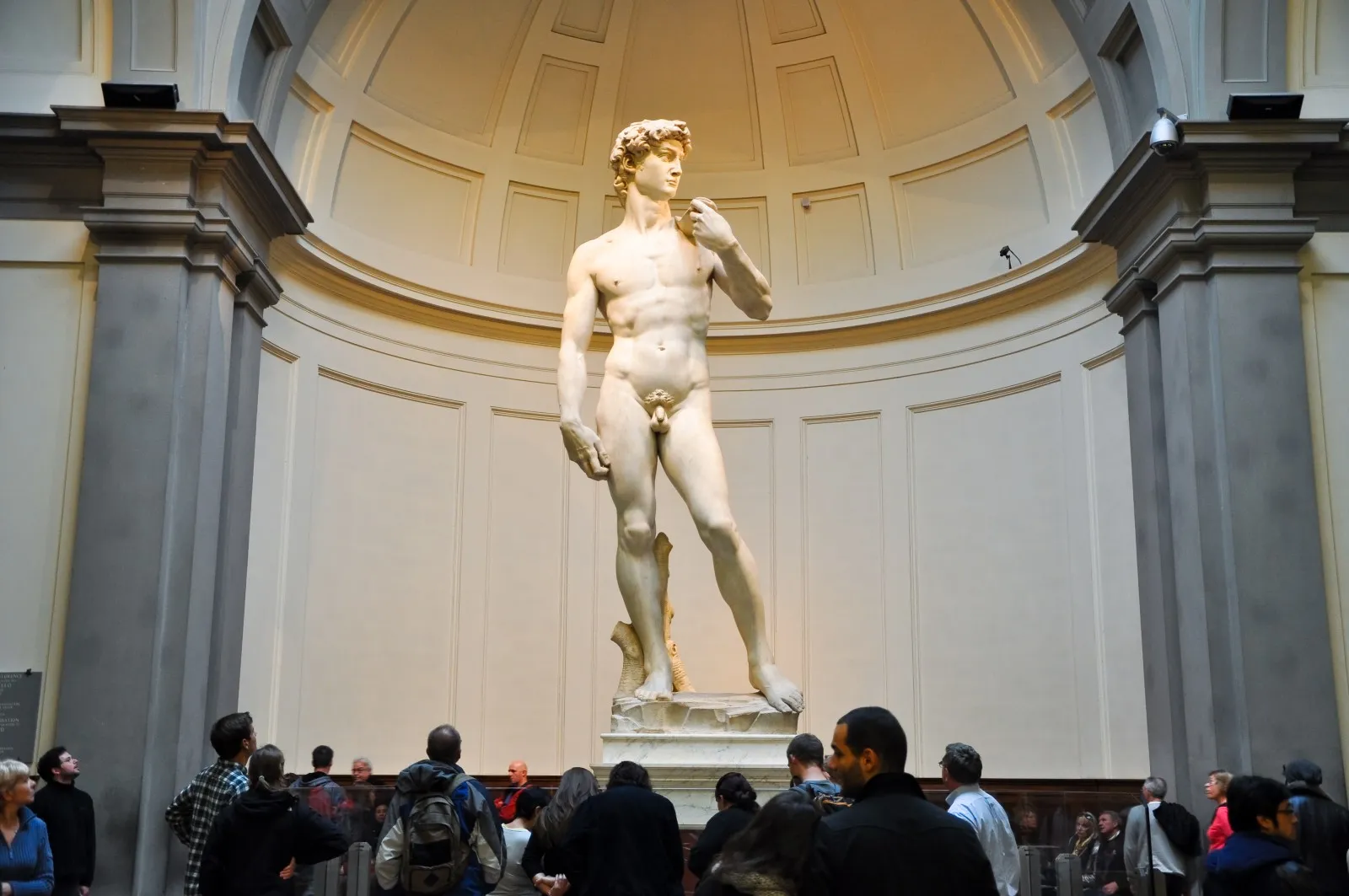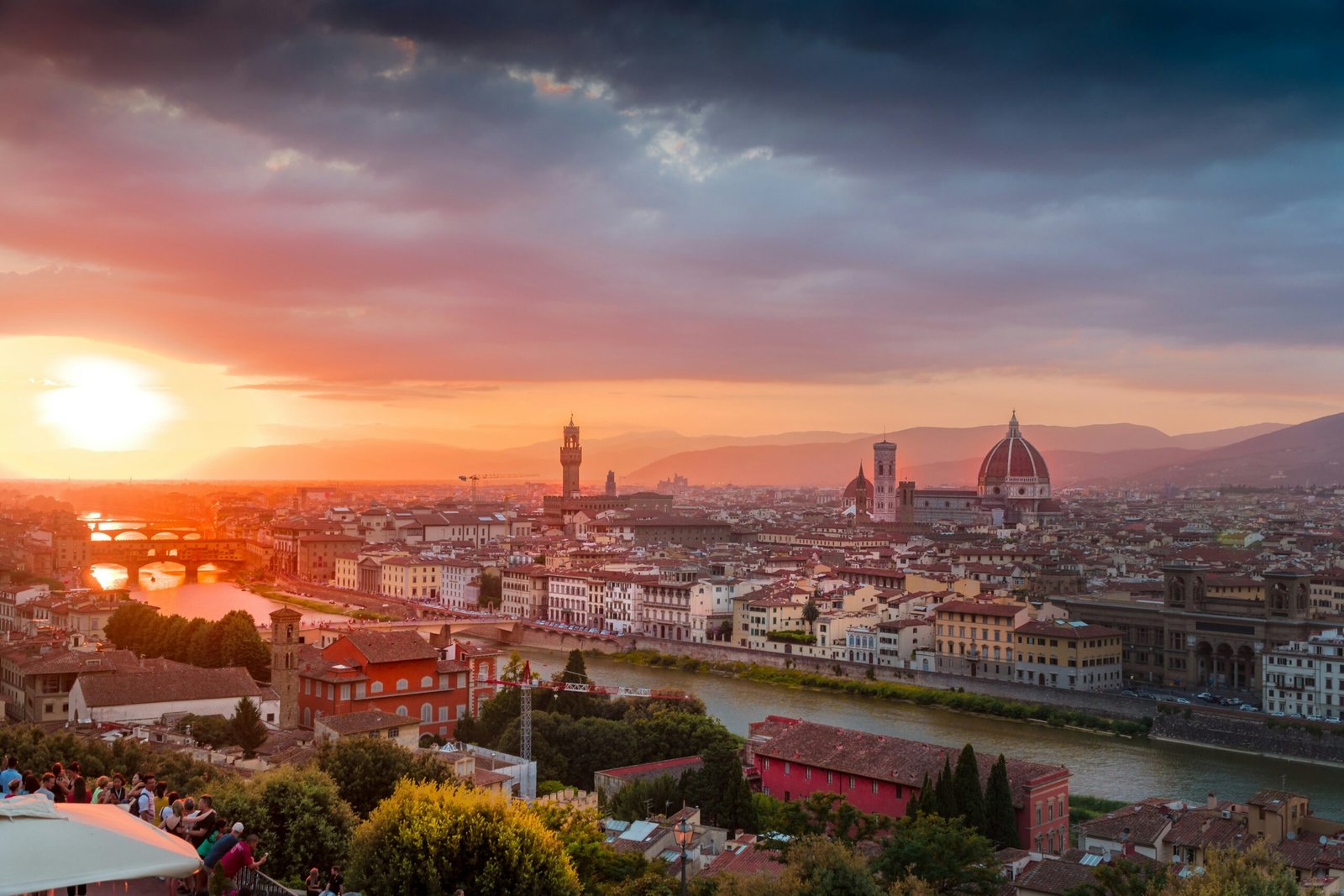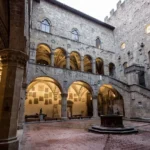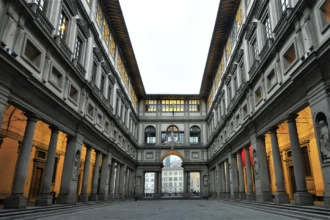Welcome to the cultural heart of Florence, where the Accademia Gallery stands as a guardian of Italy’s greatest artistic and historical treasures. In this journey through centuries of creative genius and cultural heritage, we will explore the rich collection of artworks and the historical significance of the Accademia Gallery.
Inside this article, you will also find a detailed museum map to assist you in navigating the gallery’s captivating exhibitions.
Foundation and History
The Accademia Gallery in Florence has its origins in the establishment of the Academy of Fine Arts in 1784 by Grand Duke Pietro Leopoldo of Lorraine, marking a pivotal moment in the city’s artistic landscape. The founding of the Academy was a visionary move aimed at revolutionizing art education by granting students direct access to exemplary artworks for study and inspiration. Concurrently, the gallery associated with the Academy swiftly evolved into a prestigious institution that served as a custodian of numerous artworks previously held in religious establishments that had been suppressed.
This influx of artworks from suppressed religious institutions greatly enriched the gallery’s collection and played a crucial role in defining its artistic legacy. The inclusion of masterpieces by esteemed artists like Cimabue, Giotto, and Botticelli underscored the significance of the Accademia Gallery as a cultural hub dedicated to preserving and showcasing exceptional works of art. These acquisitions not only broadened the educational resources available to aspiring artists but also transformed the gallery into a vibrant center of artistic exploration and appreciation.
Over the ensuing decades, the Accademia Gallery continued to expand its collection through strategic acquisitions and donations, solidifying its reputation as a premier institution in Florence’s artistic milieu. The patronage of subsequent rulers, particularly under the reign of Ferdinando III, further bolstered the gallery’s holdings with artworks sourced from various suppressed convents and monasteries across the Grand Duchy of Tuscany. This period of growth and enrichment laid the foundation for the gallery’s enduring legacy as a repository of Italy’s cultural heritage.
Throughout the tumultuous events of the 19th and early 20th centuries, including political upheavals and cultural shifts, the Accademia Gallery persevered as a beacon of artistic excellence and historical preservation. The gallery underwent significant renovations and expansions during the 20th century, modernizing its facilities to accommodate a growing collection and enhance the visitor experience. These efforts not only ensured the preservation of priceless artworks but also positioned the Accademia Gallery as an indispensable cultural institution within the fabric of Florence.
Today, the Accademia Gallery stands as a testament to centuries of artistic innovation and cultural stewardship. Its collection, which includes iconic masterpieces like Michelangelo’s David, continues to captivate and inspire visitors from around the globe. The gallery’s enduring commitment to education and conservation underscores its pivotal role in safeguarding Italy’s artistic heritage and fostering a deeper appreciation of art history among generations of art enthusiasts and scholars.
Unique Michelangelo Collection
The Accademia Gallery in Florence is internationally acclaimed for its unparalleled collection of Michelangelo’s sculptures, making it a mecca for art enthusiasts and scholars alike. At the heart of this collection stands the iconic colossal white marble statue of David, one of the most famous sculptures in the history of art. Crafted by Michelangelo between 1501 and 1504, David exemplifies the pinnacle of Renaissance artistry, showcasing the biblical hero in exquisite anatomical detail and profound emotional expression.
The genesis of David is a testament to Michelangelo’s unparalleled skill and vision. The artist selected a discarded marble block, considered flawed by others, and transformed it into a masterpiece that embodies perfection and divine beauty. Standing over 5 meters tall, David originally adorned the Piazza della Signoria, symbolizing Florence’s triumphant spirit and civic pride. In 1873, due to concerns about weathering and preservation, the statue found its permanent home within the protective walls of the Accademia Gallery, where it continues to captivate visitors with its majestic presence.
Beyond David, the Accademia Gallery boasts a diverse array of Michelangelo’s sculptural achievements. Among these are the mesmerizing statues known as the Prisoners, which exemplify the artist’s innovative approach to marble sculpting. These unfinished sculptures, characterized by their dynamic forms emerging from the stone, provide a profound insight into Michelangelo’s creative process and his ability to evoke raw emotion and vitality in his subjects.
The Prisoners, also referred to as the Slaves or the Awakening Captives, reveal Michelangelo’s genius in capturing the essence of movement and emotional intensity within solid marble. These sculptures, originally intended for the tomb of Pope Julius II, highlight the artist’s belief in the concept of “non finito” or unfinished work, which emphasizes the dynamic interplay between form and substance.
Visitors to the Accademia Gallery have the rare opportunity to witness Michelangelo’s artistic evolution firsthand, from the breathtaking majesty of David to the enigmatic allure of the Prisoners. Each sculpture offers a glimpse into the mind of a master craftsman who revolutionized the art of sculpture and forever shaped the course of Western art history. Through these timeless masterpieces, the Accademia Gallery continues to celebrate Michelangelo’s enduring legacy and the profound impact of his artistic vision on generations of artists and admirers.
Collection of Gold Ground Paintings
The Accademia Gallery boasts an impressive collection of gold ground paintings, renowned as one of the world’s most significant. These treasured artworks encompass a wide range of themes from the medieval and Renaissance periods, depicting both sacred and secular subjects. The collection showcases the exceptional mastery of Florentine artists in utilizing the gold ground technique to create stunning and enduring pieces of art. From religious icons to mythological scenes, these paintings highlight the intricate craftsmanship and artistic innovation of their creators. Explore the Accademia’s gold ground paintings to delve into the rich heritage of Florentine artistry, where each piece narrates a unique story of skill and creativity from Italy’s golden age. Immerse yourself in this captivating display, a testament to the enduring legacy of Renaissance artistry.
Museum Evolution
The evolution of the Accademia Gallery over the centuries has been marked by continuous enhancements aimed at enriching the visitor experience and safeguarding its invaluable cultural legacy. Through strategic reorganization and expansions, the museum has curated its collections to accentuate the significance of each artwork and its contextual ties, providing guests with a profound exploration of Florence’s vibrant artistic history. These thoughtful adaptations ensure that visitors can immerse themselves in a comprehensive journey through time, encountering masterpieces that resonate with the city’s rich cultural tapestry. By embracing innovation while honoring tradition, the Accademia Gallery remains a dynamic institution that continues to captivate and educate art enthusiasts from around the globe. Discover the evolution of this iconic museum firsthand and witness the profound impact of its ongoing commitment to preserving and showcasing Florence’s artistic heritage. Immerse yourself in a narrative that unfolds through the corridors of time, unveiling the enduring beauty and significance of Renaissance artistry.
The Halls: What You’re Going To See At The Accademia Gallery
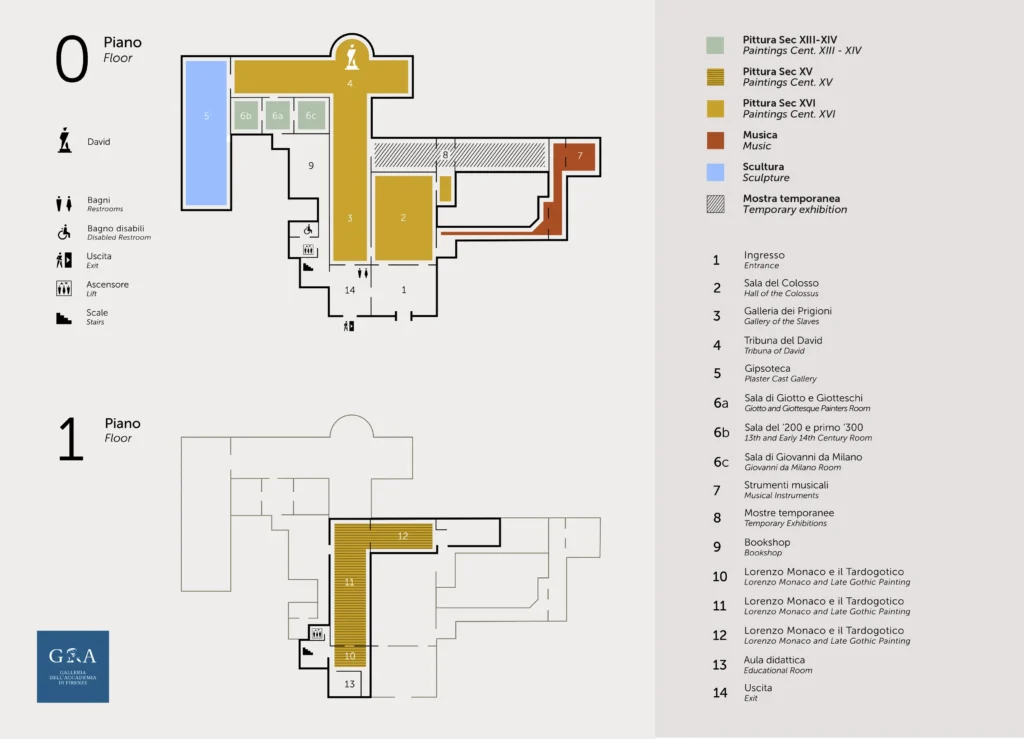
Embark on an unparalleled artistic adventure through the Accademia Gallery Rooms in Florence, a historic treasure trove showcasing masterpieces from the 13th to the 16th century. Navigate effortlessly with the Gallery Map, guiding you through the heart of Renaissance art.
- Hall of the Colossus Discover the grandeur of the Hall of the Colossus, where Giambologna’s plaster cast of the Rape of the Sabines commands attention. This entry hall sets the stage for an artistic journey through the Accademia’s treasures.
- Galleria dei Prigioni: Encounter Michelangelo’s unfinished marvels firsthand, witnessing the raw power and expressiveness of the “Prisoners” sculptures, each seemingly struggling to break free from the stone.
- Tribune The Tribune is the crown jewel, housing Michelangelo’s iconic David. This central space celebrates the genius of the Renaissance with a collection of 16th-century masterpieces that encapsulate the era’s artistic zenith.
- Gipsoteca Explore the Gipsoteca to witness the transformation of plaster models into marble marvels. This room offers a unique glimpse into the sculptor’s craft and provides copies of renowned works for an immersive educational experience.
- Florentine Gothic Rooms Step back in time in the Florentine Gothic rooms, showcasing early 13th to 14th-century paintings. Here, the legacy of Giotto’s followers, including Bernardo Daddi and Orcagna, is vividly brought to life.
- Medici Musical Instrument Collection For connoisseurs of music and history, the Medici collection of musical instruments is a symphony of craftsmanship and tradition, echoing the grandeur of the Medici court.
- Late Gothic Collection The Late Gothic collection presents masterpieces from 1370 to 1420, offering a window into Florence’s artistic evolution during a pivotal period of stylistic transition. attract art enthusiasts from around the world.
With accessible routes and guided tours, the Accademia Gallery ensures a comprehensive and inclusive experience for all art enthusiasts. Remember to download the Italian Museums App for an enriched visit, unlocking additional insights and multimedia content. Dive into the depths of art history at the Accademia Gallery Rooms – where every turn is a discovery of Florence’s rich artistic heritage.
Accessibility and Inclusion
The Accademia Gallery prioritizes accessibility and inclusion to ensure a welcoming experience for all visitors. Key exhibition spaces and restroom facilities are designed to be accessible to individuals with disabilities or reduced mobility, reflecting the museum’s commitment to accommodating diverse needs. To facilitate a seamless visit, guests are encouraged to contact the museum in advance to discuss any specific requirements or arrangements. This proactive approach allows Accademia to cater to individual needs effectively, ensuring that every visitor can fully enjoy and engage with the museum’s exceptional collections. Whether you’re planning a visit to admire Michelangelo’s David or explore the Renaissance treasures on display, rest assured that the Accademia Gallery is dedicated to providing an inclusive and enriching experience for everyone. Discover Florence’s artistic heritage with confidence, knowing that accessibility is a top priority at this iconic museum. Your journey through the galleries will be enhanced by the museum’s commitment to accessibility, making art appreciation truly accessible to all.
Visiting the Accademia Gallery: Useful Information
Opening Hours
- Open: 8:15 am to 6:50 pm
- Last Entry: 6:20 pm
- Closed: Mondays, January 1st, December 25th
Ticket Information
- Purchase Online: Official B-Ticket channel
- Reservation Call: Firenze Musei at +39 055 294883
- Reservation Cost: €4.00
- Full Price: €16
- Reduced Price: €2 (Ages 18-25)
Accessibility
- Facilities: Fully accessible with provisions for differently-abled persons
- Group Visits: Maximum of 20 people, including the guide
Visitor Guidelines
- Headsets: Mandatory for groups of 8 or more
- Security Checks: At the entrance
- Prohibited Items: Large bags, helmets
- Food and Beverages: Not allowed except for water bottles up to 0.5 liters
Museum Services
- Audio Guides: Available for €6
- Restrooms: Equipped and near the elevator
Accademia Gallery Address
Conclusions
In conclusion, the Accademia Gallery of Florence represents an invaluable treasure of art and history that continues to captivate the imagination of visitors from around the world. Through its unique collection of artworks and evocative historical narrative, the Accademia Gallery offers an unforgettable experience that celebrates the creative genius and Italian cultural heritage. Visiting this gallery is much more than a simple tourist stop; it is an immersion into the vibrant heart of Italian art and history. For more information about the Accademia Gallery and to plan your visit, please visit the museum’s official website or contact the staff for an unforgettable experience in Florence.

